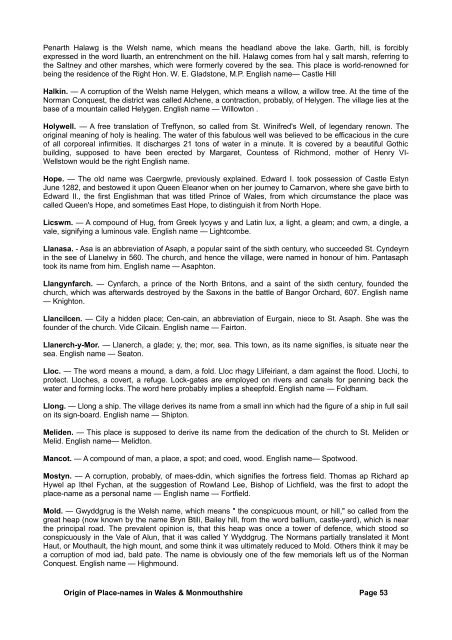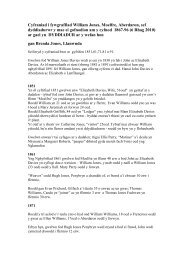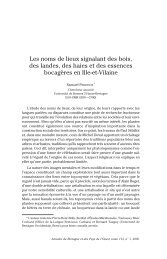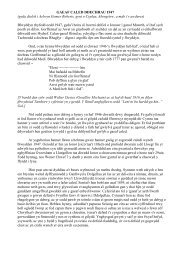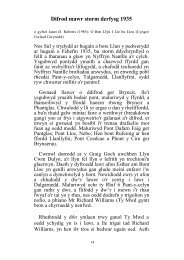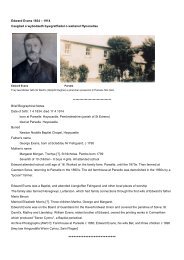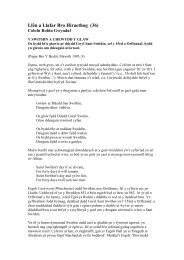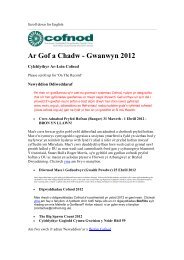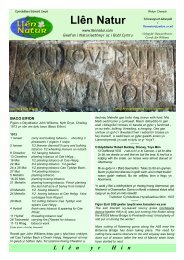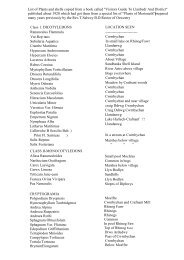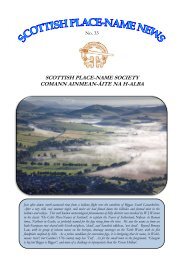Penarth Halawg is <strong>the</strong> Welsh name, which means <strong>the</strong> headl<strong>and</strong> above <strong>the</strong> lake. Garth, hill, is forciblyexpressed <strong>in</strong> <strong>the</strong> word lluarth, an entrenchment on <strong>the</strong> hill. Halawg comes from hal y salt marsh, referr<strong>in</strong>g to<strong>the</strong> Saltney <strong>and</strong> o<strong>the</strong>r marshes, which were formerly covered by <strong>the</strong> sea. This <strong>place</strong> is world-renowned forbe<strong>in</strong>g <strong>the</strong> residence <strong>of</strong> <strong>the</strong> Right Hon. W. E. Gladstone, M.P. English name— Castle HillHalk<strong>in</strong>. — A corruption <strong>of</strong> <strong>the</strong> Welsh name Helygen, which means a willow, a willow tree. At <strong>the</strong> time <strong>of</strong> <strong>the</strong>Norman Conquest, <strong>the</strong> district was called Alchene, a contraction, probably, <strong>of</strong> Helygen. The village lies at <strong>the</strong>base <strong>of</strong> a mounta<strong>in</strong> called Helygen. English name — Willowton .Holywell. — A free translation <strong>of</strong> Treffynon, so called from St. W<strong>in</strong>ifred's Well, <strong>of</strong> legendary renown. The<strong>orig<strong>in</strong></strong>al mean<strong>in</strong>g <strong>of</strong> holy is heal<strong>in</strong>g. The water <strong>of</strong> this fabulous well was believed to be efficacious <strong>in</strong> <strong>the</strong> cure<strong>of</strong> all corporeal <strong>in</strong>firmities. It discharges 21 tons <strong>of</strong> water <strong>in</strong> a m<strong>in</strong>ute. It is covered by a beautiful Gothicbuild<strong>in</strong>g, supposed to have been erected by Margaret, Countess <strong>of</strong> Richmond, mo<strong>the</strong>r <strong>of</strong> Henry VI-Wellstown would be <strong>the</strong> right English name.Hope. — The old name was Caergwrle, previously expla<strong>in</strong>ed. Edward I. took possession <strong>of</strong> Castle EstynJune 1282, <strong>and</strong> bestowed it upon Queen Eleanor when on her journey to Carnarvon, where she gave birth toEdward II., <strong>the</strong> first Englishman that was titled Pr<strong>in</strong>ce <strong>of</strong> Wales, from which circumstance <strong>the</strong> <strong>place</strong> wascalled Queen's Hope, <strong>and</strong> sometimes East Hope, to dist<strong>in</strong>guish it from North Hope.Licswm. — A compound <strong>of</strong> Hug, from Greek lycyws y <strong>and</strong> Lat<strong>in</strong> lux, a light, a gleam; <strong>and</strong> cwm, a d<strong>in</strong>gle, avale, signify<strong>in</strong>g a lum<strong>in</strong>ous vale. English name — Lightcombe.Llanasa. - Asa is an abbreviation <strong>of</strong> Asaph, a popular sa<strong>in</strong>t <strong>of</strong> <strong>the</strong> sixth century, who succeeded St. Cyndeyrn<strong>in</strong> <strong>the</strong> see <strong>of</strong> Llanelwy <strong>in</strong> 560. The church, <strong>and</strong> hence <strong>the</strong> village, were named <strong>in</strong> honour <strong>of</strong> him. Pantasaphtook its name from him. English name — Asaphton.Llangynfarch. — Cynfarch, a pr<strong>in</strong>ce <strong>of</strong> <strong>the</strong> North Britons, <strong>and</strong> a sa<strong>in</strong>t <strong>of</strong> <strong>the</strong> sixth century, founded <strong>the</strong>church, which was afterwards destroyed by <strong>the</strong> Saxons <strong>in</strong> <strong>the</strong> battle <strong>of</strong> Bangor Orchard, 607. English name— Knighton.Llancilcen. — Cily a hidden <strong>place</strong>; Cen-ca<strong>in</strong>, an abbreviation <strong>of</strong> Eurga<strong>in</strong>, niece to St. Asaph. She was <strong>the</strong>founder <strong>of</strong> <strong>the</strong> church. Vide Cilca<strong>in</strong>. English name — Fairton.Llanerch-y-Mor. — Llanerch, a glade; y, <strong>the</strong>; mor, sea. This town, as its name signifies, is situate near <strong>the</strong>sea. English name — Seaton.Lloc. — The word means a mound, a dam, a fold. Lloc rhagy Llifeiriant, a dam aga<strong>in</strong>st <strong>the</strong> flood. Llochi, toprotect. Lloches, a covert, a refuge. Lock-gates are employed on rivers <strong>and</strong> canals for penn<strong>in</strong>g back <strong>the</strong>water <strong>and</strong> form<strong>in</strong>g locks. The word here probably implies a sheepfold. English name — Foldham.Llong. — Llong a ship. The village derives its name from a small <strong>in</strong>n which had <strong>the</strong> figure <strong>of</strong> a ship <strong>in</strong> full sailon its sign-board. English name — Shipton.Meliden. — This <strong>place</strong> is supposed to derive its name from <strong>the</strong> dedication <strong>of</strong> <strong>the</strong> church to St. Meliden orMelid. English name— Melidton.Mancot. — A compound <strong>of</strong> man, a <strong>place</strong>, a spot; <strong>and</strong> coed, wood. English name— Spotwood.Mostyn. — A corruption, probably, <strong>of</strong> maes-dd<strong>in</strong>, which signifies <strong>the</strong> fortress field. Thomas ap Richard apHywel ap I<strong>the</strong>l Fychan, at <strong>the</strong> suggestion <strong>of</strong> Rowl<strong>and</strong> Lee, Bishop <strong>of</strong> Lichfield, was <strong>the</strong> first to adopt <strong>the</strong><strong>place</strong>-name as a personal name — English name — Fortfield.Mold. — Gwyddgrug is <strong>the</strong> Welsh name, which means " <strong>the</strong> conspicuous mount, or hill," so called from <strong>the</strong>great heap (now known by <strong>the</strong> name Bryn Btili, Bailey hill, from <strong>the</strong> word ballium, castle-yard), which is near<strong>the</strong> pr<strong>in</strong>cipal road. The prevalent op<strong>in</strong>ion is, that this heap was once a tower <strong>of</strong> defence, which stood soconspicuously <strong>in</strong> <strong>the</strong> Vale <strong>of</strong> Alun, that it was called Y Wyddgrug. The Normans partially translated it MontHaut, or Mouthault, <strong>the</strong> high mount, <strong>and</strong> some th<strong>in</strong>k it was ultimately reduced to Mold. O<strong>the</strong>rs th<strong>in</strong>k it may bea corruption <strong>of</strong> mod iad, bald pate. The name is obviously one <strong>of</strong> <strong>the</strong> few memorials left us <strong>of</strong> <strong>the</strong> NormanConquest. English name — Highmound.Orig<strong>in</strong> <strong>of</strong> Place-<strong>names</strong> <strong>in</strong> Wales & Monmouthshire Page 53
Maesgarmon. — Named <strong>in</strong> honour <strong>of</strong> St. Garmon, who, with Bishop Lupus, led <strong>the</strong> Britons aga<strong>in</strong>st, <strong>and</strong>obta<strong>in</strong>ed a glorious victory over, <strong>the</strong> Pagan Saxons <strong>and</strong> Picts. This took <strong>place</strong> <strong>in</strong> Easter week, 440, <strong>and</strong> is tothis day called <strong>the</strong> " Hallelujah Victory." Nehemiah Griffiths, Esq., <strong>of</strong> Rhual, erected an obelisk <strong>in</strong> 1736, withan <strong>in</strong>scription to commemorate <strong>the</strong> event. English name — Garmon's Field.Maelor. — A corruption <strong>of</strong> mael, mart, <strong>and</strong> llawr, ground, signify<strong>in</strong>g a <strong>place</strong> where trade could be carried onunmolested. Maelawr was a free trader, who favoured importations, <strong>in</strong> consequence <strong>of</strong> which he was sla<strong>in</strong>.Some th<strong>in</strong>k <strong>the</strong> name is a contraction <strong>of</strong> max lawr, which signifies pla<strong>in</strong> l<strong>and</strong>. English name — Martham.Newmarket. — The old Welsh name was Rhiwlyf- wyd, but Pennant calls it Treflawnyd, which signifies " a<strong>place</strong> full <strong>of</strong> corn." About <strong>the</strong> beg<strong>in</strong>n<strong>in</strong>g <strong>of</strong> <strong>the</strong> 18th century, John Wynn, Esq., <strong>of</strong> Gop, <strong>the</strong> <strong>the</strong>n owner <strong>of</strong> <strong>the</strong>estate, succeeded <strong>in</strong> gett<strong>in</strong>g a market here, which had been a long-felt desideratum, <strong>and</strong>, probably, from thatcircumstance, <strong>the</strong> <strong>place</strong> was henceforth called Newmarket.Northop. — An abbreviation <strong>of</strong> North Hope, so called to dist<strong>in</strong>guish it from East Hope. Llaneurga<strong>in</strong> is <strong>the</strong>ancient Welsh name. The church was dedicated to Eurga<strong>in</strong>, <strong>the</strong> daughter <strong>of</strong> Maelgwyn Gwynedd, <strong>and</strong> a sa<strong>in</strong>t<strong>of</strong> <strong>the</strong> sixth century.Nanerch. — A compound <strong>of</strong> nant, a brook, <strong>and</strong> erch, a dark colour. English name — Dunbrook.Nerquis. — A corruption <strong>of</strong> Nercwys; ner, a sovereign; cwys, a furrow. Cwys dir, a furrow <strong>of</strong> l<strong>and</strong>. Englishname — Lordton.Overton. — A corruption <strong>of</strong> Owrtyn, which is probably a compound <strong>of</strong> gowyro, to make a little oblique, <strong>and</strong>d<strong>in</strong>, a fortified hill. It was anciently called Owrtyn Fadoc from Madoc ab Meredydd, <strong>the</strong> pr<strong>in</strong>ce <strong>of</strong> Powys, whois supposed to have built a castle here. The town is situated on a ris<strong>in</strong>g em<strong>in</strong>ence near <strong>the</strong> river Dee. Englishname— Slanthill.Pentre Hobyn. — Pentre, a village; hobyn, a pig. Hanerkob, a flitch or side <strong>of</strong> a hog. This <strong>place</strong> <strong>in</strong> ancienttimes was famous for its abundance <strong>of</strong> wild boars. Vide Rhos-hobyn, Denbigh. English name — Boarton.Penygelli. — Petty head, end; y, <strong>the</strong>; gelli, grove. English name — Grovesend.Penymynydd. — The name signifies a <strong>place</strong> situated on a mounta<strong>in</strong>. — English name — Mountton.Pontbleiddyn. — Pont, a bridge; bleiddyn, a wolfs cub. English nane — Wolfbridge.Prestatyn. — A corruption <strong>of</strong> Prysgoed-dd<strong>in</strong>. In ancient times <strong>the</strong>re was a castle here called Prysgoed-dd<strong>in</strong>,evidently built by <strong>the</strong> Kymry, a few ru<strong>in</strong>s <strong>of</strong> which still rema<strong>in</strong>. Prys, a covert; coed, woed; d<strong>in</strong>, fortress; <strong>the</strong>name signifies a <strong>place</strong> <strong>of</strong> resort. Some say it is a corruption <strong>of</strong> Prys Tyda<strong>in</strong>, Tyda<strong>in</strong>'s <strong>place</strong> <strong>of</strong> resort. Prysform a part <strong>of</strong> many <strong>names</strong>, Prysaddfed, Pryseddfod, Prystalyn, &c. English name— CoverthamRhuddlan. — This name is variously derived. Some derive it from Robert de Ro<strong>the</strong>lan, a military chief, whovisited <strong>the</strong> <strong>place</strong>. O<strong>the</strong>rs derive it from rhudd, red; <strong>and</strong> glan, bank, from <strong>the</strong> town be<strong>in</strong>g situated on <strong>the</strong> redbanks <strong>of</strong> <strong>the</strong> river Clwyd. The castle was anciently called Castell Coch yn Ngwernfar, i.e., <strong>the</strong> red castle on<strong>the</strong> great pla<strong>in</strong>. The most natural ,explanation is Rhyd-y-llan, <strong>the</strong> ford by <strong>the</strong> church. The name is writteneven now by <strong>the</strong> oldest <strong>in</strong>habitants Rhydlan. There are three fords <strong>in</strong> <strong>the</strong> district: Rhyd-y-ddau-ddwfr, <strong>the</strong> ford<strong>of</strong> <strong>the</strong> two waters, which is fordable to this day; For-tyd, <strong>the</strong> ford by <strong>the</strong> sea; <strong>and</strong> Rhyd-y-llan, <strong>the</strong> ford by <strong>the</strong>church. To <strong>the</strong> north <strong>of</strong> this ford, on an em<strong>in</strong>ence, <strong>the</strong>re is a church dat<strong>in</strong>g back many centuries; <strong>and</strong> <strong>the</strong> fordis spanned by a bridge which dates back to 1595. Ere <strong>the</strong> build<strong>in</strong>g <strong>of</strong> this bridge, <strong>the</strong> church-goers,undoubtedly, were wont to cross <strong>the</strong> river by means <strong>of</strong> this ford, hence it was called Rhyd-y-llan. It is spelt bysome Rhyddlan, perhaps from its hav<strong>in</strong>g been made a free borough by Edward I., whose son wasproclaimed here <strong>the</strong> Pr<strong>in</strong>ce <strong>of</strong> Wales, <strong>the</strong> first English Pr<strong>in</strong>ce <strong>of</strong> Wales, 1283. Morfa Rhuddlan is <strong>the</strong>celebrated marsh where that memorable battle was fought <strong>in</strong> 795 between <strong>the</strong> Saxons under Offa <strong>and</strong> <strong>the</strong>Welsh under <strong>the</strong> valiant Caradog, when <strong>the</strong> last fell <strong>in</strong> <strong>the</strong> conflict. Many <strong>names</strong> <strong>in</strong> <strong>the</strong> vic<strong>in</strong>ity po<strong>in</strong>t to <strong>the</strong> sadcatastrophe, such as Bryny saeihau, hill <strong>of</strong> arrows; Bryn y lladfa, hill <strong>of</strong> slaughter; Pant y gwae, <strong>the</strong> vale <strong>of</strong>woe; Cat yr orsedd, field <strong>of</strong> <strong>the</strong> throne or tribunal. We adopt Rhyd-y-Llan as <strong>the</strong> correct word<strong>in</strong>g. Englishname — Fordchurch or Fordton.Rhyl. — This beautiful water<strong>in</strong>g-<strong>place</strong> is situated at <strong>the</strong> extremity <strong>of</strong> Saltney marsh, which is called <strong>in</strong> WelshMorfa yr Hal, or Yr Haleg. We f<strong>in</strong>d <strong>the</strong> <strong>names</strong> Penarleg near Chester, <strong>and</strong> Plas-yr-hal near Ruth<strong>in</strong>, <strong>and</strong> an oldOrig<strong>in</strong> <strong>of</strong> Place-<strong>names</strong> <strong>in</strong> Wales & Monmouthshire Page 54
- Page 1 and 2:
HANDBOOK OF THE ORIGIN OF PLACE-NAM
- Page 3 and 4:
§ § § § §The Author begs to st
- Page 5 and 6: pitiful cries of the railway offici
- Page 7 and 8: Bishop Percy says that "in England,
- Page 9 and 10: The city of Chester is still popula
- Page 11 and 12: There's Cumwhitton, Cumwhinton, Cum
- Page 13 and 14: Llwyn in its primary' sense means a
- Page 15 and 16: PLACE-NAMES IN WALES.Wales. — The
- Page 17 and 18: Church are generally dedicated to e
- Page 19 and 20: think he was a contemporary of St.
- Page 21 and 22: Rhosbeirio. — Rhos, a moor, a dry
- Page 23 and 24: of Brecknock," states that this vic
- Page 25 and 26: Cam cnwir ef Cwmdu,Cwm gwyn yw & n
- Page 27 and 28: Penderyn. — A corruption probably
- Page 29 and 30: Ardudwy. — Ar, upon or above; tud
- Page 31 and 32: to mark its pre-eminence over the o
- Page 33 and 34: Some think that eirw is a corruptio
- Page 35 and 36: present form — Caerfyrddin.Abergw
- Page 37 and 38: place of refuge; hence the name. En
- Page 39 and 40: Llansawyl. — The church was dedic
- Page 41 and 42: eject. The village took its name fr
- Page 43 and 44: house, and attempted to kill an inf
- Page 45 and 46: Gwydir. — Prima facie one may tak
- Page 47 and 48: Nefyn. — The church was probably
- Page 49 and 50: DENBIGHSHIRE.Anglicized form of Din
- Page 51 and 52: Llangollen. — From Collen, a sain
- Page 53 and 54: hands into their pockets to pay a c
- Page 55: Cefn. — The name signifies a ridg
- Page 59 and 60: Abertridwr. — Tridwr, three water
- Page 61 and 62: it is said, was originally built by
- Page 63 and 64: Cwmllynfell. — Cwm, a narrow vale
- Page 65 and 66: Gwarycaeau. — Gwdr, the nape of t
- Page 67 and 68: means a cultivated region, a vale,
- Page 69 and 70: Penrhiwfer.- Pen, head, top; rhiw,
- Page 71 and 72: Port Talbot. — So called in 1835
- Page 73 and 74: Trealaw. — This appellation was g
- Page 75 and 76: Aberdyfi. — So called from its si
- Page 77 and 78: Llanddwywe. — From Dwywau, a desc
- Page 79 and 80: Crickhowell and some in the directi
- Page 81 and 82: Griffithstown. — This village was
- Page 83 and 84: and gwy, water. Treiddiod troth tna
- Page 85 and 86: derive Tintern from din, fortified
- Page 87 and 88: Caersws. — It appears that the Ro
- Page 89 and 90: English name — Ervylton.Llanymech
- Page 91 and 92: Angle. — Probably from the angle-
- Page 93 and 94: Gellyswick. — Another hybrid. Gel
- Page 95 and 96: that the two rivers in their flowin
- Page 97 and 98: ecame the bishop of the see, and wa
- Page 99 and 100: earth formerly stood on a summit on
- Page 101 and 102: Pilleth. — A corruption of pwll,
- Page 103 and 104: Howells, Rev. J., Mountain AshHowel
- Page 105 and 106: Williams, D., PenywernWilliams, Rev


